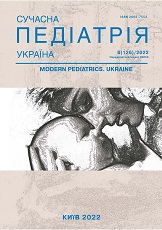Successful experience of treatment of the infantile hemangioma of the critical localization zone with the local β-blockers
DOI:
https://doi.org/10.15574/SP.2022.126.92Keywords:
hemangioma, children, treatment, local β-blockersAbstract
Infantile hemangioma (IH) is the most common benign vascular tumor in infants and children under one year of age. 12% of children with IH have a tendency to develop dangerous complications, the development of which depends on the area of tumor localization, its size, growth rate, and the patient's age. Careful history taking and physical examination make it possible to verify IH located in critical localization zones (physiological openings, neck, palms and feet) where complications are most likely to develop and to choose the correct method of treatment in a timely manner. Difficulties may arise for the doctor when choosing between the appointment of local or systemic therapy with β-blockers when the IH is located in the critical localization zone.
Purpose - to present possibilities and successful experience of choosing between systemic and local treatment IH with β-blockers in the critical localization zone in a child.
Clinical case. 2-month-old boy’s parents came to the clinic with complaints about the appearance of a bright red neoplasm in the area of the upper lip in the child, which appeared 6 days after birth and had a tendency to active increase and infiltration of soft tissue. After examining, a clinical diagnosis was made: infantile hemangioma in the critical localization zone (in the area of the skin of the upper lip) in the proliferation phase. Ultrasound diagnosis of the tumor with a special skin sensor made it possible to establish the depth of infiltration. Taking into account the localization of the tumor next to the vital opening, the rapid growth of the tumor, the risk of breast-feeding disruption due to tumor infiltration of soft tissues and the child's age, a decision was made to refer the child for further examination to rule out contraindications to the appointment of systemic β-blockers. During the follow-up examination, local treatment with the β-blocker propranolol was prescribed. During the next two weeks of using local β-blockers, the growth of the hemangioma stopped, ultrasound recorded the cessation of deep proliferation. According to the obtained results, the doctor made a decision to continue treatment with local β-blockers without switching to systemic treatment. An 8-month course of treatment with local β-blockers made it possible to achieve complete stabilization and further regression of the tumor with an excellent cosmetic effect.
Conclusions. Infantile hemangiomas are dangerous tumors in children of the first year of life and require careful observation and timely treatment. The article presents a clinical case of a child with critical localization IH, who was prescribed systemic β-blockers according to treatment protocols. In this case, the treatment with local β-blockers made it possible to obtain an excellent therapeutic and cosmetic effect.
The research was carried out in accordance with the principles of the Helsinki Declaration. The informed consent of the patient was obtained for conducting the studies.
No conflict of interests was declared by the authors.
References
Bauland CG, Luning TH, Smit JM et al. (2011). Untreated hemangiomas:growth pattern and residual lesions. Plast Reconstr Surg. 127 (4): 1643-1648. https://doi.org/10.1097/PRS.0b013e318208d2ac; PMid:21460670
Chen ZY, Wang QN, Zhu YH et al. (2019). Progress in the treatment of infantile hemangioma. Ann Transl Med. 7 (22): 692. https://doi.org/10.21037/atm.2019.10.47; PMid:31930093 PMCid:PMC6944559
Darrow DH, Greene AK, Mancini AJ, Nopper AJ. (2015). Section on Dermatology, Section on Otolaryngology-Head and Neck Surgery, and Section on Plastic Surgery. Diagnosis and management of infantile hemangioma: executive summary. Pediatrics. 136 (4): 786-791. https://doi.org/10.1542/peds.2015-2482; PMid:26416928
Ding Y, Zhang JZ, Yu SR et al. (2020). Risk factors for infantile hemangioma: a meta-analysis. World J Pediatr. 16 (4): 377-384. https://doi.org/10.1007/s12519-019-00327-2; PMid:31853885
Gorbatyuk OM (2019) Hemangiomas in infants: modern therapeutic tactic. Neonatology, surgery and perinatal medicine. ІХ; 2 (32): 67-72. https://doi.org/10.24061/2413-4260.IX.2.32.2019.10
Haggstrom AN, Drolet BA, Baselga E et al. (2006). Prospective study of infantile hemangomas: clinical characteristics predicting complications and treatment. Pediatrics. 118 (3): 882-887. https://doi.org/10.1542/peds.2006-0413; PMid:16950977
Harter N, Mancini AJ. (2019). Diagnosis and management ofinfantile hemangiomas in the neonate. Pediatr Clin North Am. 66 (2): 437-459. https://doi.org/10.1016/j.pcl.2018.12.011; PMid:30819347
International Society for the Study of Vascular Anomalies. (2014). ISSVA classification of vascular anomalies. Accessed: April 2015. URL: issva.org/classification.
Konoplytskyі DV. (2019). Minimally-invasive treatment of hemangioma for children. Paediatric Surgery. Ukraine. 1(62): 11-17. https://doi.org/10.15574/PS.2019.62.11
Krowchuk DP, Frieden IJ, Mancini AJ et al. (2019). Clinical practice guideline for the management of infantile hemangiomas. Pediatrics. 143 (1): e20183475. https://doi.org/10.1542/peds.2018-3475; PMid:30584062
Leaute-Labreze C, Harper JI, Hoeger PH. (2017). Infantile haemangioma. Lancet. 390 (10089): 85-94. https://doi.org/10.1016/S0140-6736(16)00645-0; PMid:28089471
Pereyaslov AA. (2019). Modern classification of hemangiomas. Paediatric Surgery. Ukraine. 2(63): 73-78. https://doi.org/10.15574/PS.2019.62.73
Pereyaslov AA, Rybalchenko VF, Losev OO. (2020). Infantile hemangioma. Peadiatric Surgery. Ukraine. 3 (68): 48-57. https://doi.org/10.15574/PS.2020.68.49
Rybalchenko V, Rusak P, Shevchuk D, Rybalchenko I, Konoplitsky D. (2020). Evolution of hemangiom's treatment strategy in children and the contribution of domestic scientists. Paediatric Surgery.Ukraine. 1(66):64-71. https://doi.org/10.15574/PS.2020.66.64
Smith CJF, Friedlander SF, Guma M et al. (2017). Infantile hemangiomas:an updated review on risk factors, pathogenesis, and treatment. Birth Defects Res. 109 (11): 809-815. https://doi.org/10.1002/bdr2.1023; PMid:28402073 PMCid:PMC5839165
Downloads
Published
Issue
Section
License
Copyright (c) 2022 Modern pediatrics. Ukraine

This work is licensed under a Creative Commons Attribution-NonCommercial 4.0 International License.
The policy of the Journal “MODERN PEDIATRICS. UKRAINE” is compatible with the vast majority of funders' of open access and self-archiving policies. The journal provides immediate open access route being convinced that everyone – not only scientists - can benefit from research results, and publishes articles exclusively under open access distribution, with a Creative Commons Attribution-Noncommercial 4.0 international license (СС BY-NC).
Authors transfer the copyright to the Journal “MODERN PEDIATRICS. UKRAINE” when the manuscript is accepted for publication. Authors declare that this manuscript has not been published nor is under simultaneous consideration for publication elsewhere. After publication, the articles become freely available on-line to the public.
Readers have the right to use, distribute, and reproduce articles in any medium, provided the articles and the journal are properly cited.
The use of published materials for commercial purposes is strongly prohibited.

